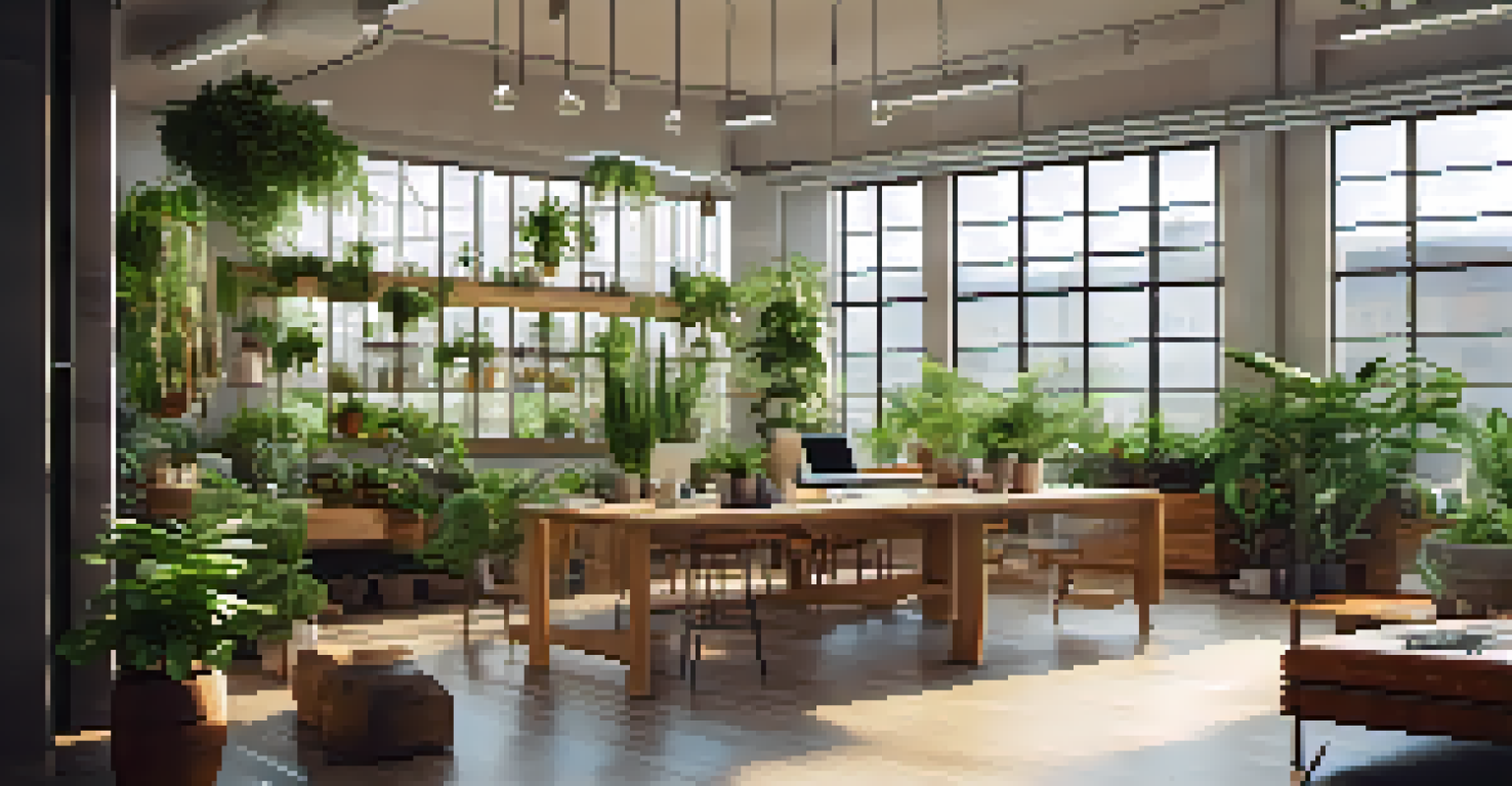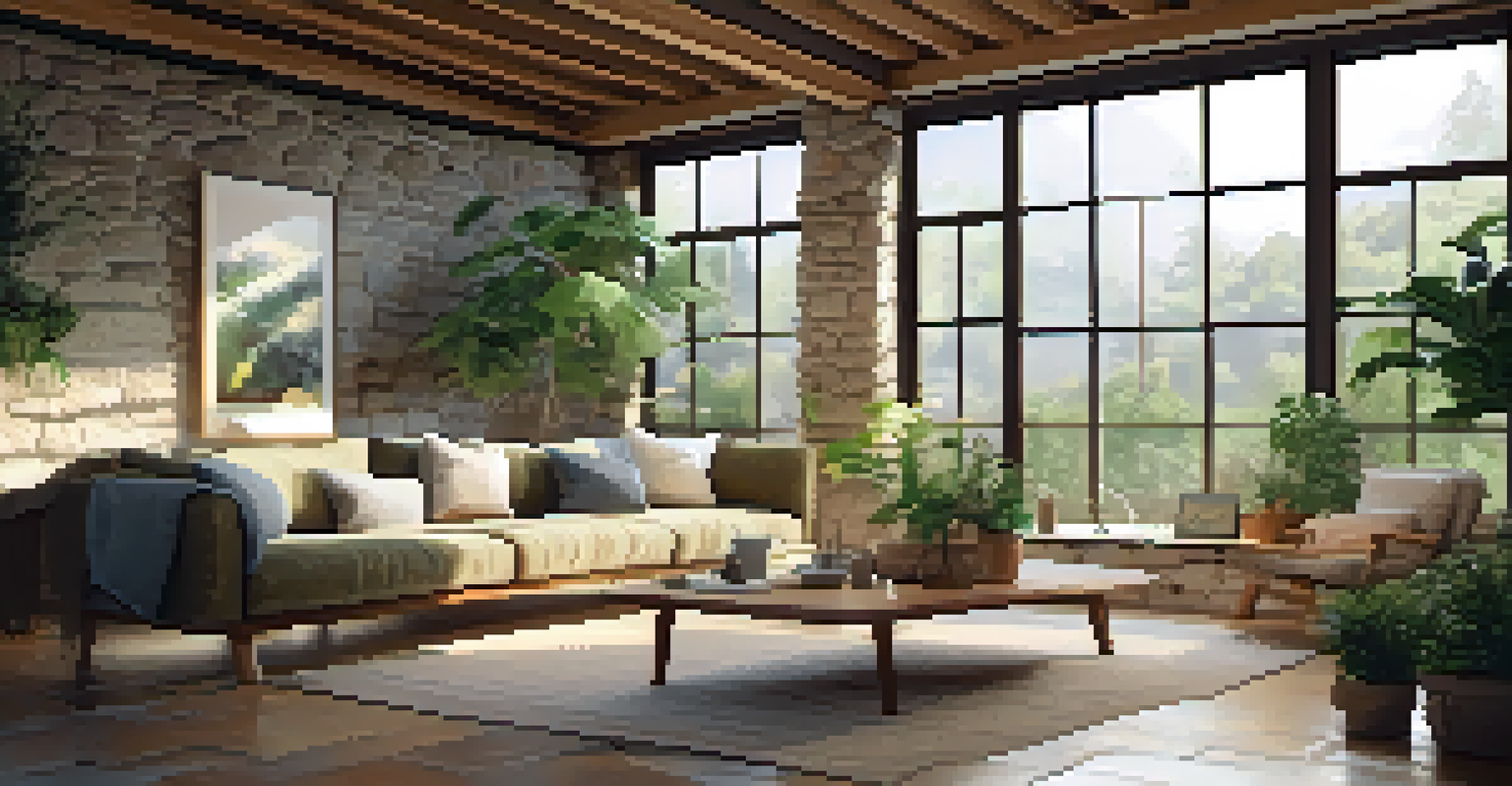Biophilic Design: Creating Spaces That Nurture Well-Being

Understanding Biophilic Design and Its Benefits
Biophilic design is an innovative approach that integrates natural elements into our built environments. This design philosophy aims to create spaces that help us feel more connected to nature, which can significantly enhance our overall well-being. By incorporating aspects like natural light, plant life, and organic materials, biophilic design promotes a healthier and more enjoyable living or working environment.
The clearest way into the Universe is through a forest wilderness.
Research has shown that being in nature, even in small doses, can reduce stress and anxiety levels. For example, studies indicate that spending time in green spaces can lower cortisol levels, the body's primary stress hormone. This means that biophilic design doesn't just make our spaces aesthetically pleasing; it actively contributes to our mental and emotional health.
Moreover, biophilic design can enhance creativity and productivity. When we feel more connected to nature, our minds become clearer, and we can think more creatively. This is especially important in workplaces where innovative thinking is crucial, making biophilic spaces not only beneficial for well-being but also for performance.
Incorporating Natural Light in Design
Natural light is one of the cornerstones of biophilic design, as it can have profound effects on our mood and health. Well-lit spaces that utilize sunlight can enhance our circadian rhythms, leading to better sleep patterns and improved energy levels throughout the day. This is why many architects and designers prioritize large windows and skylights in their projects.

The impact of natural light goes beyond just visibility; it can also bring warmth and comfort to a space. Imagine sitting in a room filled with sunlight streaming through a window, versus being in a dimly lit space. The former can uplift your spirits and make you feel more at home, which is exactly what biophilic design aims to achieve.
Biophilic Design Enhances Well-Being
Integrating natural elements into our spaces can reduce stress, improve mental health, and boost creativity.
Additionally, incorporating light fixtures that mimic natural sunlight can also contribute to this effect when natural light is scarce. By blending these elements, designers can create environments that feel bright and welcoming, keeping our well-being at the forefront of their designs.
The Role of Plants in Biophilic Spaces
Plants are a quintessential aspect of biophilic design, and for good reason. They not only beautify a space but also purify the air, which can lead to healthier indoor environments. By integrating plants into homes and offices, we invite nature inside, creating a refreshing and rejuvenating atmosphere.
Nature does not hurry, yet everything is accomplished.
Having greenery in our surroundings has been linked to reduced stress and improved concentration. Studies show that people working in plant-rich environments report higher levels of satisfaction and productivity. So, whether it’s a small potted plant on your desk or a vertical garden in a common area, every little bit counts toward enhancing our well-being.
Moreover, plants can serve as natural sound barriers, helping to absorb noise and create a more peaceful environment. This is particularly beneficial in urban settings where noise pollution can be distracting. By thoughtfully placing plants, we can cultivate spaces that promote relaxation and focus.
Using Natural Materials for a Grounded Feel
Incorporating natural materials like wood, stone, and bamboo into our spaces can create a warm and inviting atmosphere. These materials not only add aesthetic appeal but also connect us to the earth, fostering a sense of grounding and stability. When we surround ourselves with nature-inspired textures, we are reminded of the outdoors, which can be both calming and restorative.
Using materials that are sustainable and eco-friendly also aligns with the principles of biophilic design. For example, reclaimed wood or sustainably sourced stone not only reduces our carbon footprint but also tells a story of nature's resilience. This connection to the environment can enrich our experience and appreciation of the spaces we inhabit.
Natural Light Boosts Mood and Health
Maximizing natural light in design helps regulate our circadian rhythms, leading to better sleep and energy levels.
Furthermore, the tactile quality of natural materials can enhance our sensory experience. Touching a rough stone wall or running our fingers over a smooth wooden surface can evoke feelings of comfort and connection, making our spaces feel more alive and engaging.
Water Features: Adding Serenity to Spaces
Water features, whether it's a small fountain or a large pond, play a vital role in biophilic design by adding tranquility and a sense of calm. The sound of flowing water can have a soothing effect, helping to mask background noise and creating a peaceful environment. This auditory connection to nature can significantly reduce stress levels and promote relaxation.
Moreover, water elements can enhance the visual appeal of a space, reflecting light and creating dynamic interactions with the surrounding environment. Imagine a serene garden with a gentle stream or a modern office with a stylish indoor water wall; these features can transform an ordinary space into a peaceful oasis.
Additionally, water features can attract wildlife, such as birds and butterflies, further connecting us to nature. This interaction with local fauna enriches our experience and reminds us of the beauty of the natural world, reinforcing the core principles of biophilic design.
Creating Outdoor Spaces for Connection
Outdoor spaces are essential in biophilic design as they provide a direct connection to nature. Parks, gardens, and balconies allow us to step outside and immerse ourselves in the beauty of the natural world. These spaces can serve as a retreat from the hustle and bustle of daily life, offering a place to relax and recharge.
Moreover, outdoor environments encourage social interaction and community engagement. Gathering with friends or colleagues in a garden or patio can foster relationships and create a sense of belonging. This social aspect is vital for our well-being, reminding us that we are part of something larger than ourselves.
Plants Improve Indoor Environments
Incorporating plants not only beautifies spaces but also purifies the air and increases productivity.
Incorporating features like seating areas, pathways, and native plants can enhance the usability and appeal of outdoor spaces. By designing these areas thoughtfully, we can create inviting environments that encourage us to spend more time outside, ultimately benefiting our physical and mental health.
The Future of Biophilic Design in Architecture
As awareness of the importance of well-being in our environments grows, biophilic design is gaining traction in the architecture and interior design industries. Forward-thinking architects are increasingly prioritizing natural elements and sustainable practices in their projects. This shift reflects a broader movement towards creating spaces that nurture both people and the planet.
The integration of technology also plays a significant role in the future of biophilic design. Innovations like smart windows that adjust to natural light and automated irrigation systems for plants can enhance our connection to nature while maintaining convenience. This marriage of technology and nature can create dynamic living environments that cater to our evolving needs.

Ultimately, the future of biophilic design lies in its ability to adapt and respond to the challenges of modern living. By continuously pushing the boundaries of how we connect with nature, we can create spaces that not only enhance our well-being but also promote a more harmonious relationship with the environment.